South Bank at Quarry Trails
- 93 units available
- Studio • 1 bed • 2 bed • 3 bed
- Amenities
In unit laundry, Patio / balcony, Granite counters, Pet friendly, Stainless steel, Walk in closets + more

Are you struggling with different types of mold and want to make sure you’re protecting your health while maintaining a safe and clean living space?
While a little black stuff in the shower might seem harmless, not all mold is the same. Some mold types can trigger allergies, cause structural damage, or pose serious health risks. If you're a renter, being able to identify common apartment molds and understand their implications for your home is the first step toward taking action.
Mold is a type of fungus that thrives in damp, humid environments. It can rapidly reproduce by releasing microscopic spores into the air. It is known to grow on a variety of surfaces, including walls, ceilings, fabric, and wood, and in areas with poor ventilation or water damage.
Some apartment mold is completely harmless, while other types can cause health issues, including:
Mold often appears as black, green, or white spots and is typically accompanied by a strong, musty odor. The good news is that early detection and moisture control can help prevent mold growth before it becomes a significant issue.
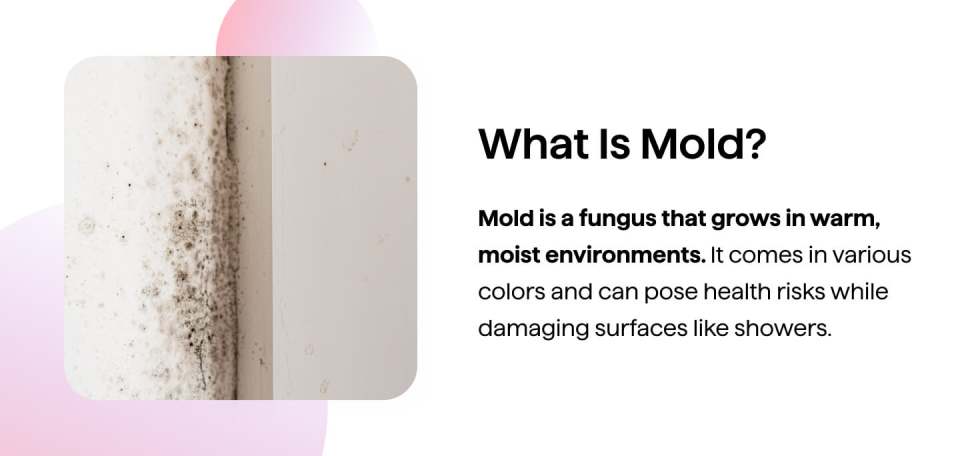
Mold can thrive on moisture, oxygen, a food source, and a warm environment. When all of those conditions exist in your apartment, mold can take hold on surfaces fast, sometimes in less than a day. Something as simple as a leaky pipe, a heavy spill, or flood damage is all it takes to get mold growing in hidden areas of your apartment. The good news is you can take a few proactive steps to keep mold spores from turning your space into their next home.
Many people confuse mold and mildew because they are both types of fungi, but there are key differences between them. They appear different and exhibit distinct growth patterns.
Mildew is typically white, gray, or yellow and grows on the surface of damp areas, like your shower walls or windowsills, making it easier to clean. Apartment mold can appear black, green, or brown and often penetrates deeper into walls, ceilings, or porous materials. It can sometimes cause structural damage.
While mildew usually causes minor irritation, mold is more likely to trigger allergic reactions and serious health concerns, particularly in individuals with preexisting respiratory conditions.

Apartment mold loves hiding places with excess moisture or poor airflow, so it’s important to inspect areas like bathrooms, kitchens, and laundry rooms. Take a closer look:
You can also look for discoloration or a musty smell around walls, ceilings, windowsills and HVAC units.
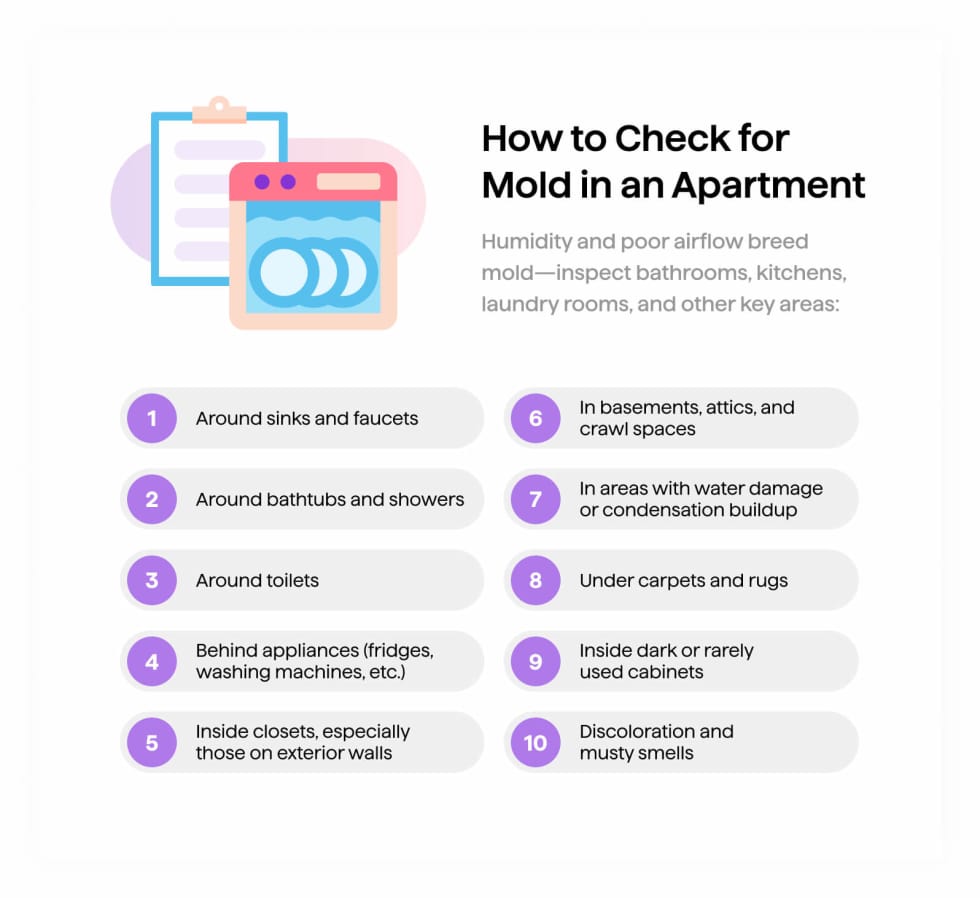
Different types of mold can show up at the same time in your apartment, and not all pose the same level of risk. Some trigger mild allergy symptoms, while others can lead to more serious health issues.
Mold is generally classified into three categories:
Below are 12 common types of mold found in homes, including how to identify them and where they typically grow.
Cladosporium is one of the most common indoor mold types you’ll find in an apartment. It appears black, green, or brown and typically grows on wood, carpet, and fabrics. You might find it behind toilets, under sinks, or on damp window sills. While it's not the most dangerous mold you’ll encounter, it can still cause allergic reactions, such as sneezing, coughing, or itchy eyes.
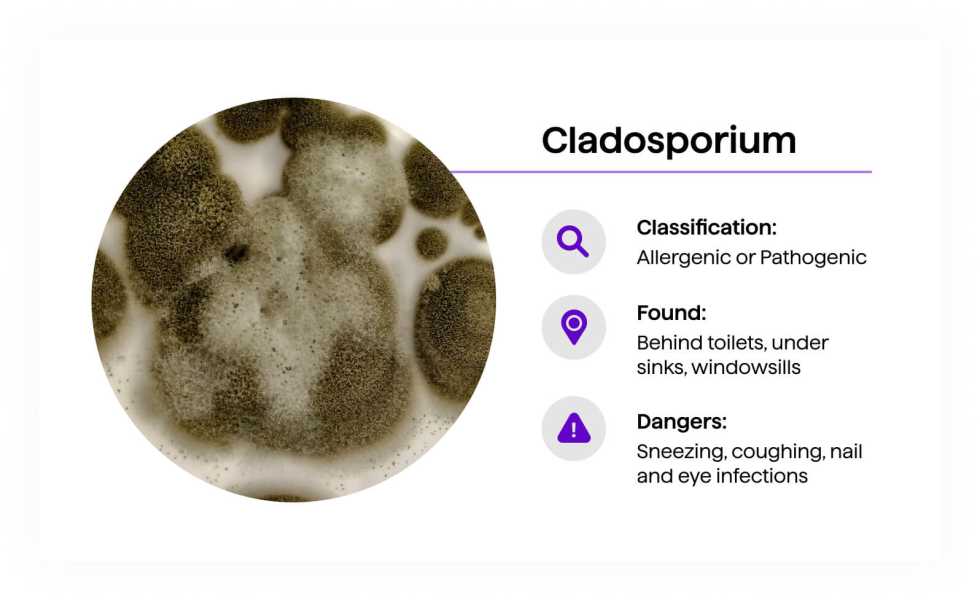
Aspergillus often appears as a powdery mold in shades of green, white, or yellow. It thrives in dusty environments, such as air conditioning units and insulation. Some strains of Aspergillus can be harmful, particularly for individuals with a compromised immune system or preexisting respiratory conditions. Prolonged exposure may lead to lung infections or chronic sinus issues.
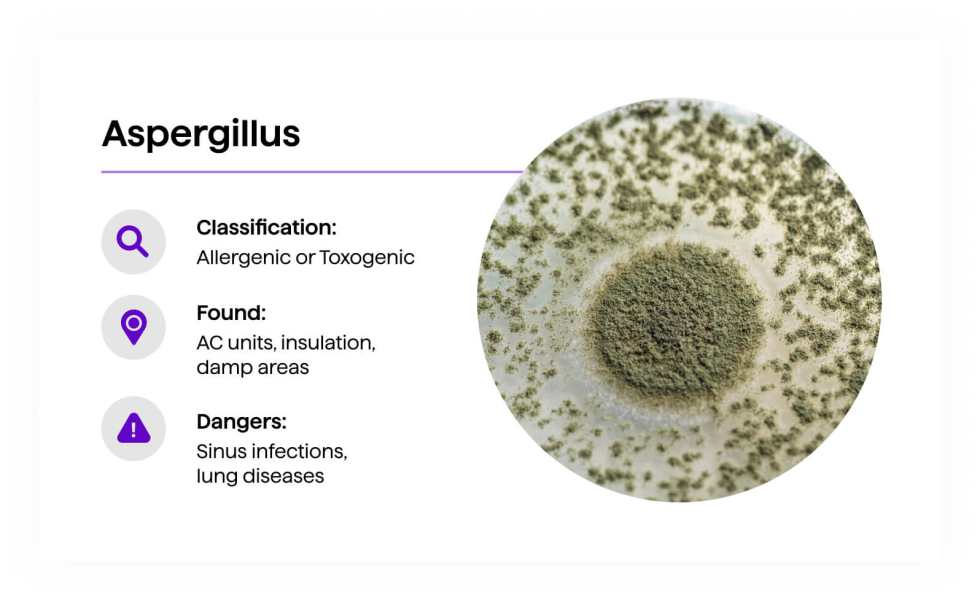
Yes, this is the same penicillium that is the source of the antibiotic penicillin, but in this context, it is definitely not your friend. This blue or green mold is known for its fast growth and fuzzy texture. Penicillium often grows on water-damaged materials like wallpaper, mattresses, or upholstered furniture. It can produce strong, musty odors and trigger allergy-like symptoms.
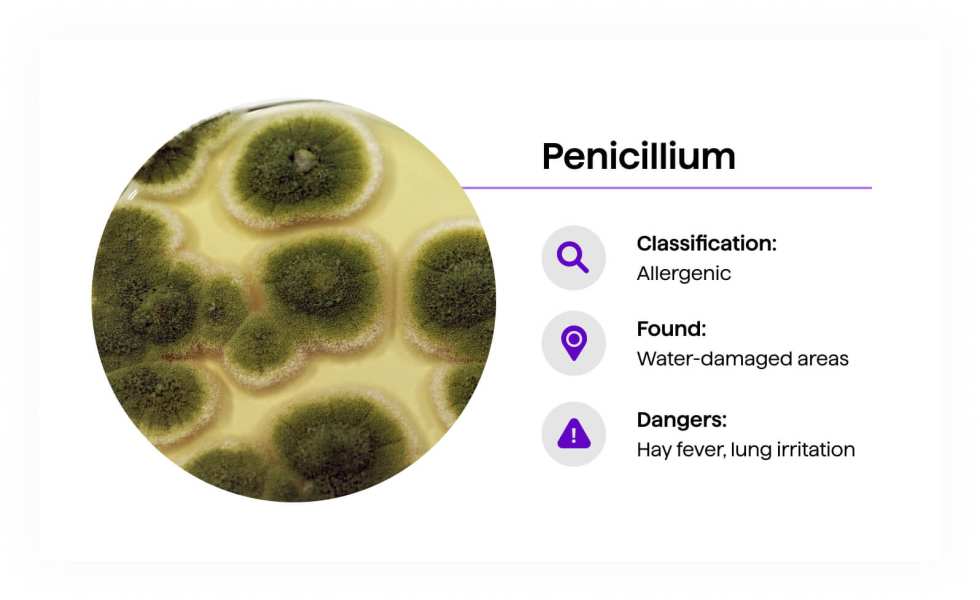
Beware, this is the infamous “toxic black mold” you’ve probably heard about and are dreading. It’s typically dark green or black and often appears in areas with chronic water damage. Stachybotrys produces mycotoxins that can lead to serious health issues, including fatigue, headaches, difficulty breathing, and neurological symptoms. If you suspect black mold in apartment, professional remediation is a must.
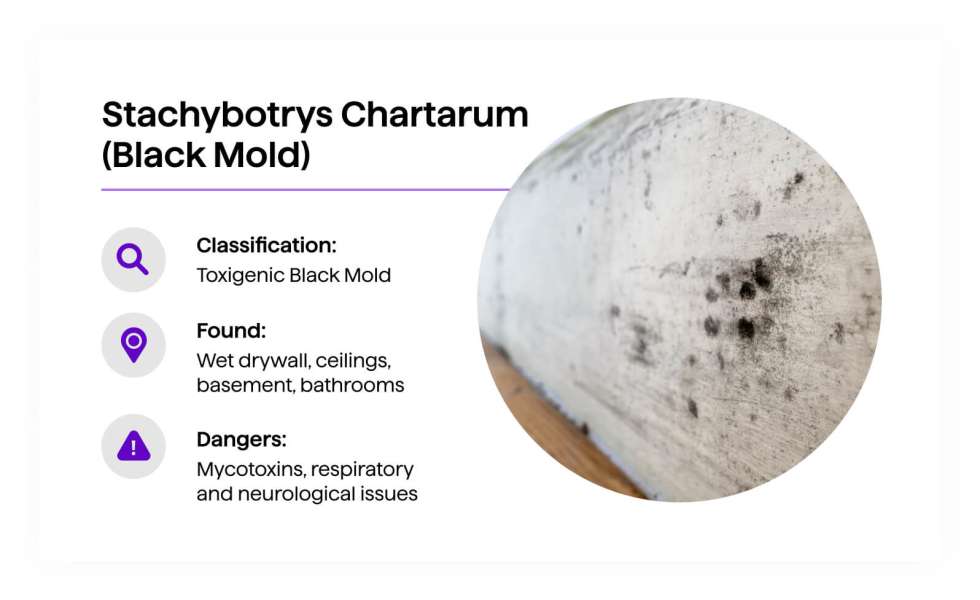
Alternaria is a common apartment mold found in showers, under sinks, and around windows. It’s dark in color with a velvety texture. Alternaria spreads quickly in moist areas and is known to cause allergic reactions, particularly in people with asthma or other respiratory sensitivities.

Acremonium starts its journey like a damp smear that turns into a fine, powdery mold. It may be white, gray, pink or even orange, which can make it difficult to recognize at first glance. It’s usually found in older apartment buildings with long-standing water damage. Acremonium can also release harmful toxins over time and should be handled carefully—especially if you spot it near humidifiers, drain pans, or air conditioning coils that could compromise your air quality.
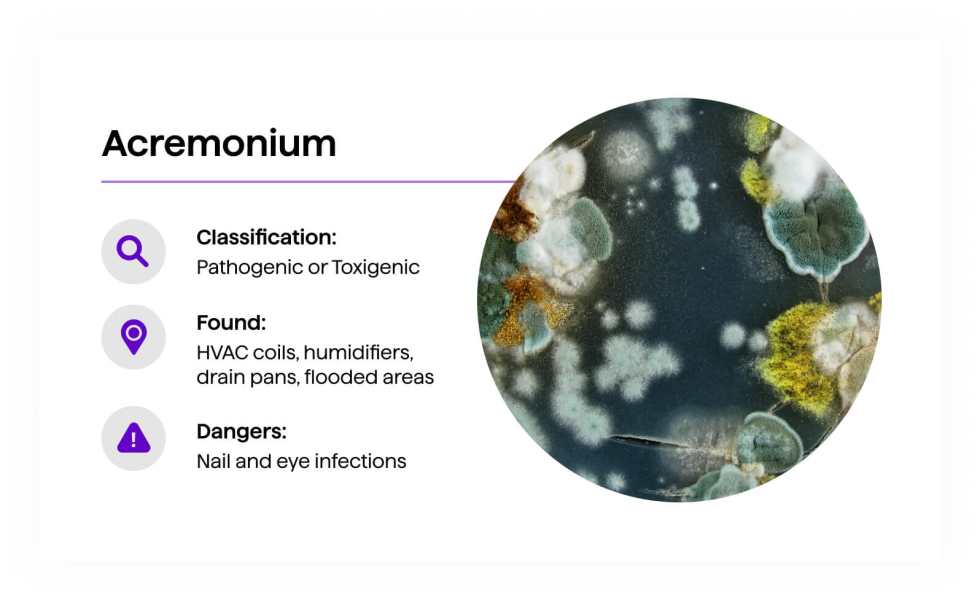
Aureobasidium is a less common apartment mold but is commonly found in bathrooms, kitchens, and anywhere moisture lingers. Aureobasidium can appear pink, black, brown, or cream-colored. Fortunately, this apartment mold isn’t highly toxic, but it can irritate the skin and eyes. It’s wise to avoid touching it and call for removal if you see it spreading near tile grout or around leaky windows.
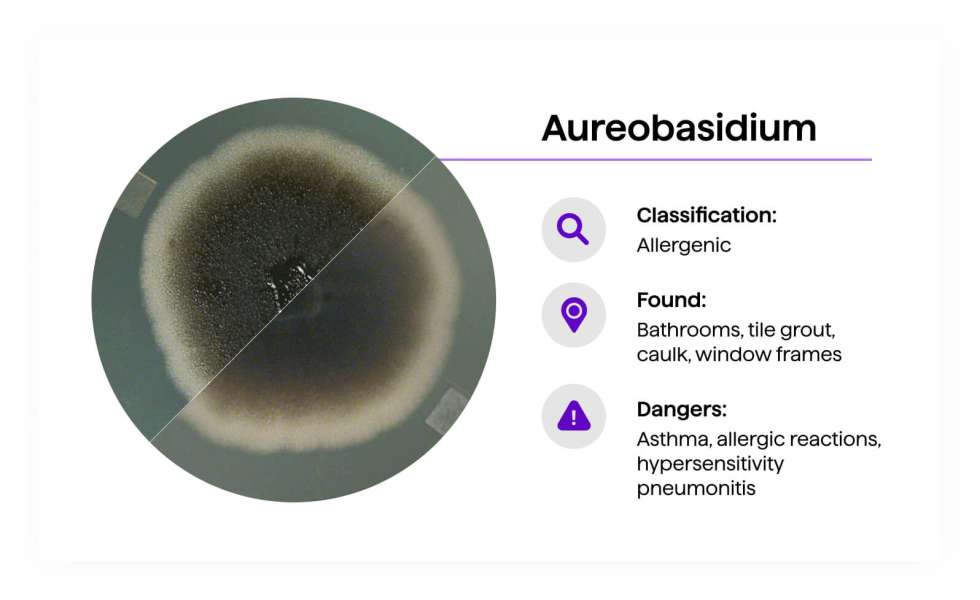
Chaetomium thrives on soggy drywall, wallpaper, and wooden beams. If anything in your apartment has been hit by water damage, chaetomium will find it. This type of mold is usually dark with a cotton-like texture and a musty odor. It’s also known for triggering asthma and sinus flare-ups. Its mycotoxins could pose a greater health risk if left untreated, especially in enclosed or poorly ventilated spaces.
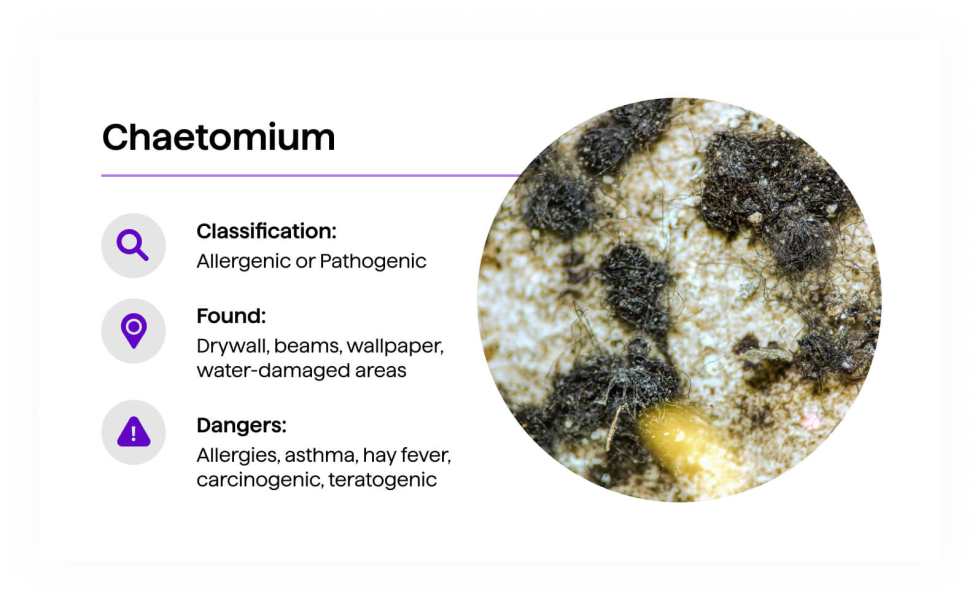
Fusarium is a frequent garden invader that can also sneak indoors and settle into carpet fibers, wallpaper, or fabric in damp, poorly ventilated spaces. It’s often pink, white, or even reddish-purple and spreads quickly across porous surfaces. When it grows in apartments, it can cause allergies and structural issues when ignored, so don’t let its soft pastel colors fool you; it’s persistent and causes mass destruction.
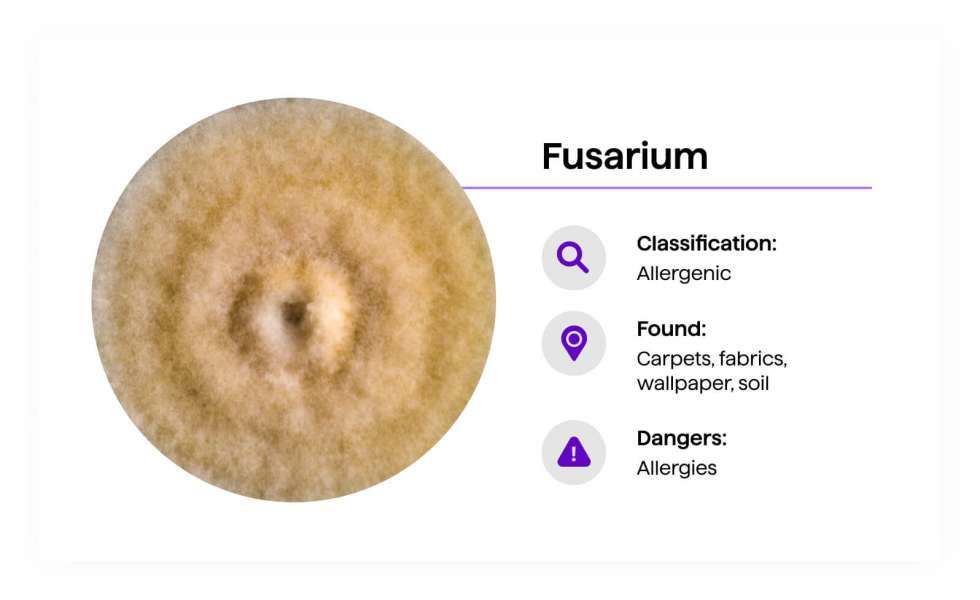
Mucor is a fast-growing mold that thrives in dusty or humid indoor spaces like HVAC systems, carpets, and insulation. It’s white or yellow with a thick, cottony look that can take over quickly if left unchecked. It won’t cause too many problems for healthy individuals but can cause issues for anyone with a weakened immune system—this mold can trigger infections and breathing problems.
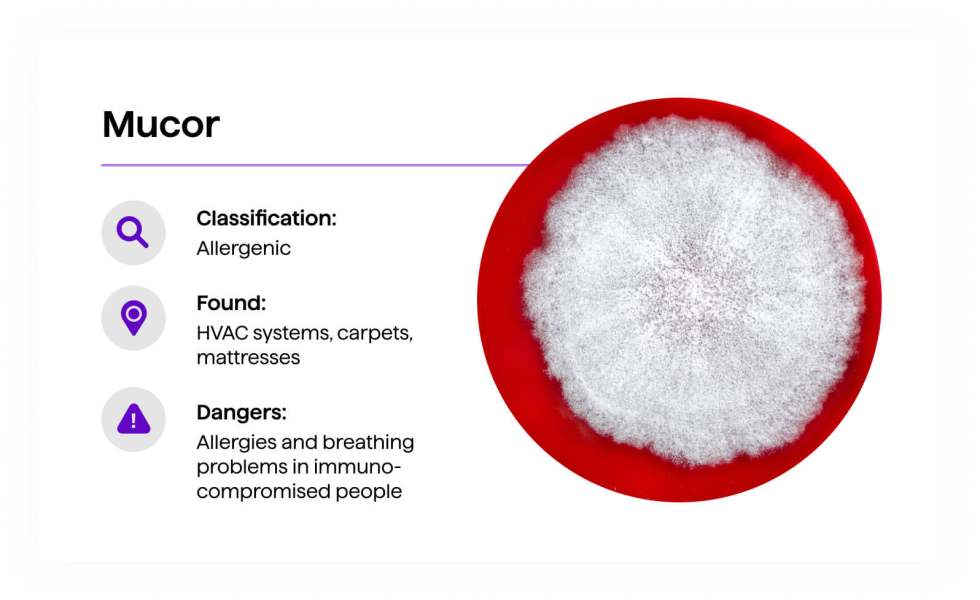
This green-and-white mold loves to hide and destroy everything in its path. Trichoderma grows on damp wood, wallpaper, and carpet and is notorious for causing wood to rot. Aside from the structural damage it can cause, you and your pets may experience an intense allergic reaction and respiratory problems around it. If you notice fuzzy patches creeping along baseboards or behind appliances, call your landlord right away. This mold species has the potential to rapidly escalate and turn into an unwanted roommate.
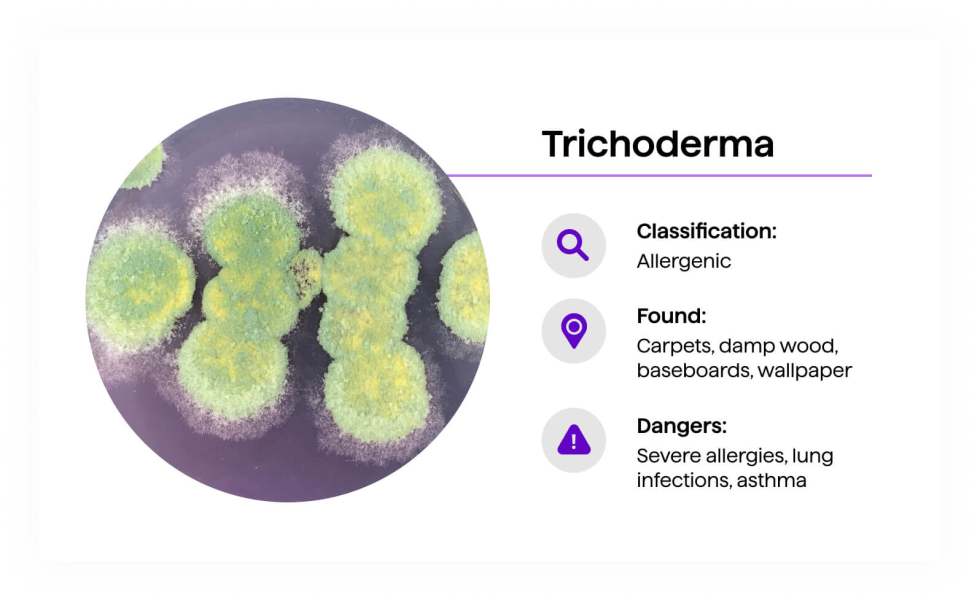
Often found in homes that have experienced flooding or prolonged moisture exposure, Ulocladium is that dark, fluffy mold that spreads through airborne spores. You’ll most likely see it in kitchens, bathrooms, and basements. Once it takes hold, it can trigger asthma, hay fever, and other respiratory issues. It also closely resembles more toxic molds, so leave the identification and cleanup to the professionals.
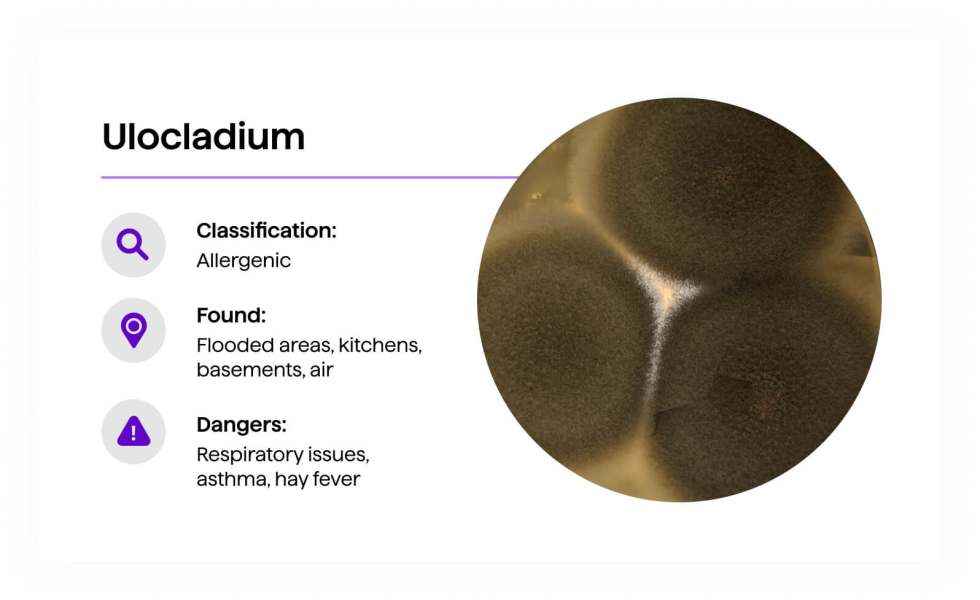
Not all types of mold are visible, but more often than not, the signs are subtle:
Even if you can’t see it, mold may be growing inside walls or under flooring, especially if you just had a leak or a flood in your apartment.
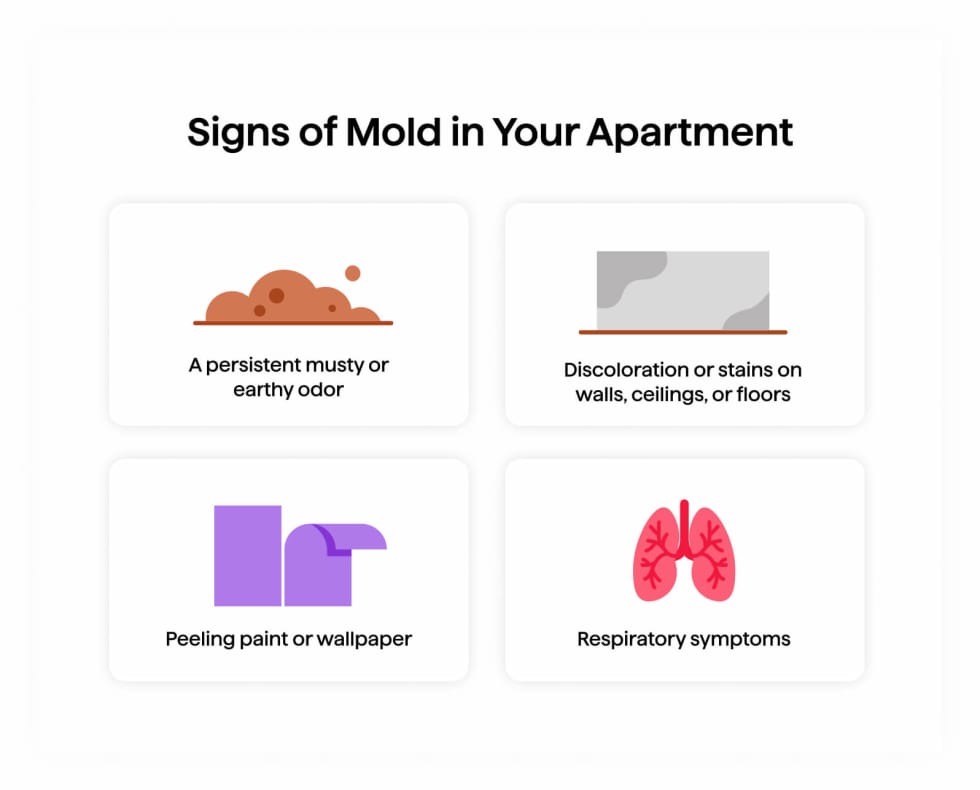
Yes. Mold is especially dangerous because it releases spores and toxic compounds called mycotoxins into the air, which can trigger a range of health problems. Many people experience allergy-like symptoms such as sneezing, coughing, and skin irritation. Other common signs of mold exposure include:
If you have asthma, a compromised immune system, or chronic respiratory conditions, you may experience more severe reactions—including breathing difficulties or lung infections.
Beyond the health risks, mold can also damage your walls, ceilings, and belongings, leading to costly and complicated repairs if left unchecked.
If the mold in your apartment is only covering an area of a square foot or less, you may be able to handle it yourself before contacting a professional remediation team. First of all, bleach isn’t always the best solution. It often just wipes away the surface discoloration and doesn’t kill the mold at the source.
Instead, one common DIY method is to spray the moldy surface with white vinegar, let it sit for at least an hour with good airflow, and then scrub thoroughly with a stiff brush. However, vinegar has its limits and won’t work well on larger patches because it can’t reach deep into the surfaces where mold takes root.
If the mold has already spread and is larger than a square foot, or you suspect it is black mold, call your landlord and leave the cleanup to the professionals. A larger patch means the mold has taken root beneath the surface and won’t come off with basic cleaning or a simple vinegar solution.
You and your landlord can work out who is responsible for cleaning up the problem. If you created the issue through spills and poor apartment hygiene, you may be responsible. Otherwise, a landlord should handle issues such as leaking pipes and building problems. A professional mold inspection can help pinpoint the source and clarify who should foot the bill.
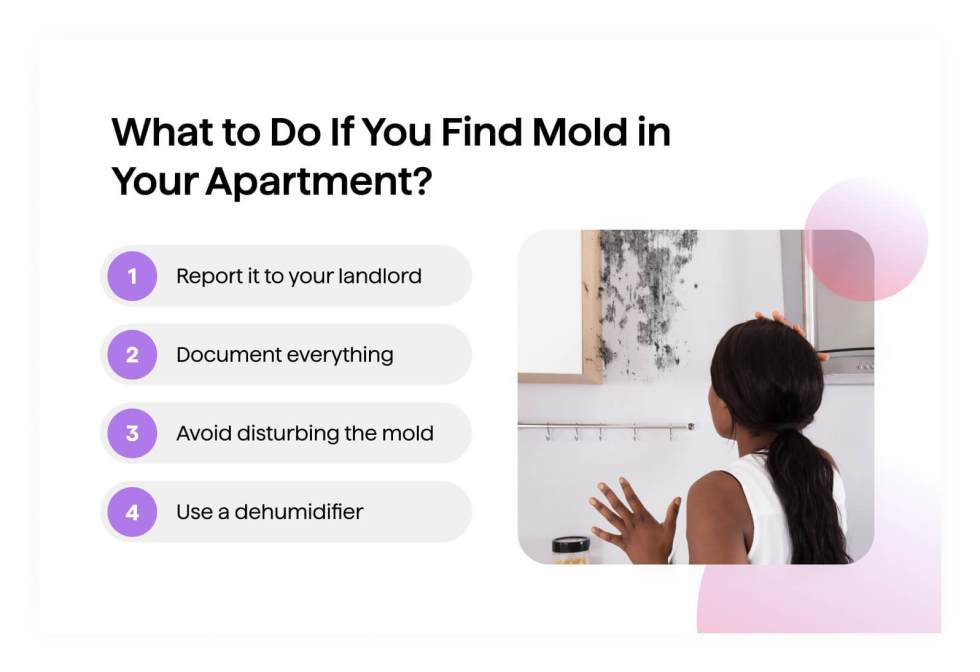
Believe it or not, it's not always illegal to have mold in your apartment. However, some states have laws that require landlords to deal with mold and other safety issues. For example, in Colorado, landlords are legally required to address mold problems that pose health risks under the state’s Warranty of Habitability law. Remediation must start within 96 hours of written notice. If the mold significantly impacts a tenant’s health or safety, landlords are also required to provide alternative housing at no cost during repairs.
The laws in your state will look different. It's important to look up the laws in your state to determine your rights as a tenant.
Your landlord should always be your first point of contact when you discover any mold types. But not all states have specific laws requiring landlords to clean up mold, like Ohio. While landlords must maintain safe and habitable housing under general habitability standards, there are no explicit state regulations that require them to remediate mold unless it's clearly tied to a code violation or structural issue. In such cases, tenants may need to rely on local health departments or building codes to try and push for some kind of resolution.
If you live in a state without such laws and your landlord isn’t interested in taking action, it’s important to schedule a professional mold inspection as soon as possible to identify what caused the mold in the first place. Once you know whether it’s caused by tenant activity or a building issue, you’ll be in a better position to negotiate who’s responsible for covering the cost of the removal.
Prevention is easier than cleanup. Here’s how to keep apartment mold at bay:
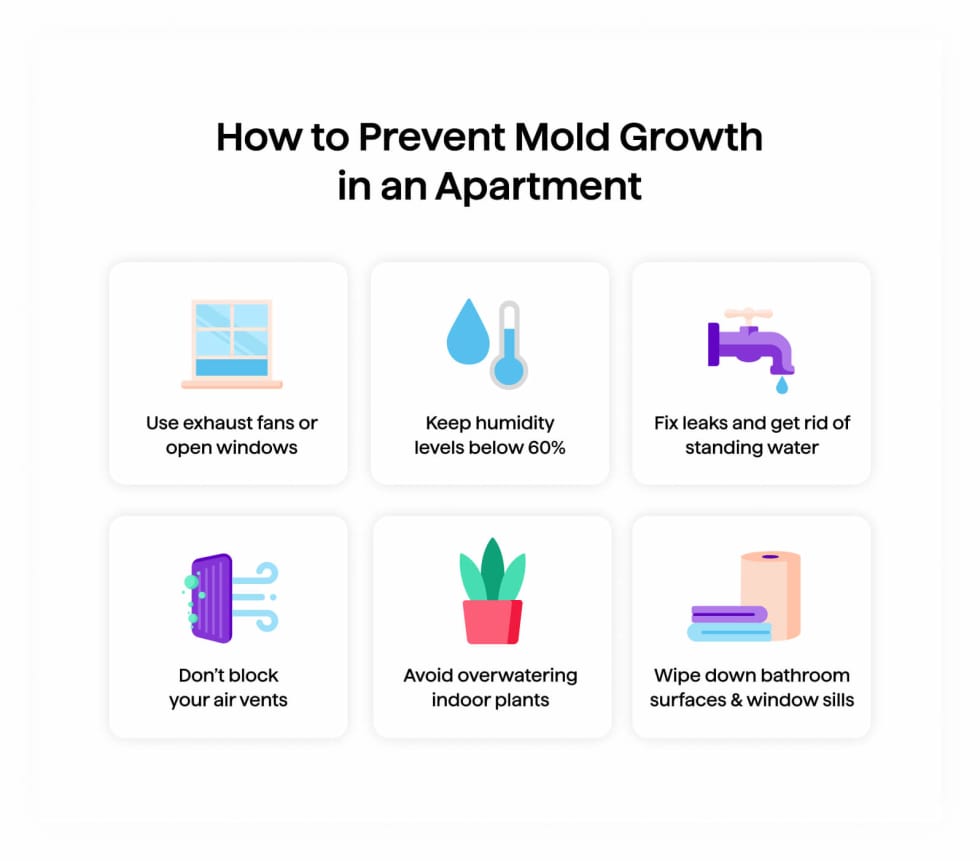
Mold removal starts with the right tools, and knowing when to call in a pro. Here are four effective ways to get rid of mold, from everyday solutions to expert help.
Mix one cup of bleach with four cups of water in a spray bottle. Spray the affected area, let it sit briefly, then scrub with a stiff brush. Bleach works well on non-porous surfaces like tile or sinks but isn’t ideal for wood or drywall.
Tip: Always ventilate the space and wear gloves when working with bleach.
Hydrogen peroxide (3% to 10% concentration) is less harsh than bleach and still effective at killing mold. Spray it directly on the surface, let it sit for 10 minutes, then scrub and wipe clean. It works well in bathrooms, kitchens, and on appliances.
White vinegar is a natural mold killer. Spray it undiluted onto the moldy surface and let it sit for an hour. Wipe clean with a damp cloth. For stubborn spots, sprinkle baking soda on the area before spraying to boost cleaning power.
If the mold covers a large area (10 square feet or more), smells musty, or might be toxic (like black mold), it’s best to call a certified professional. Experts have the right equipment to safely remove mold and prevent it from spreading.
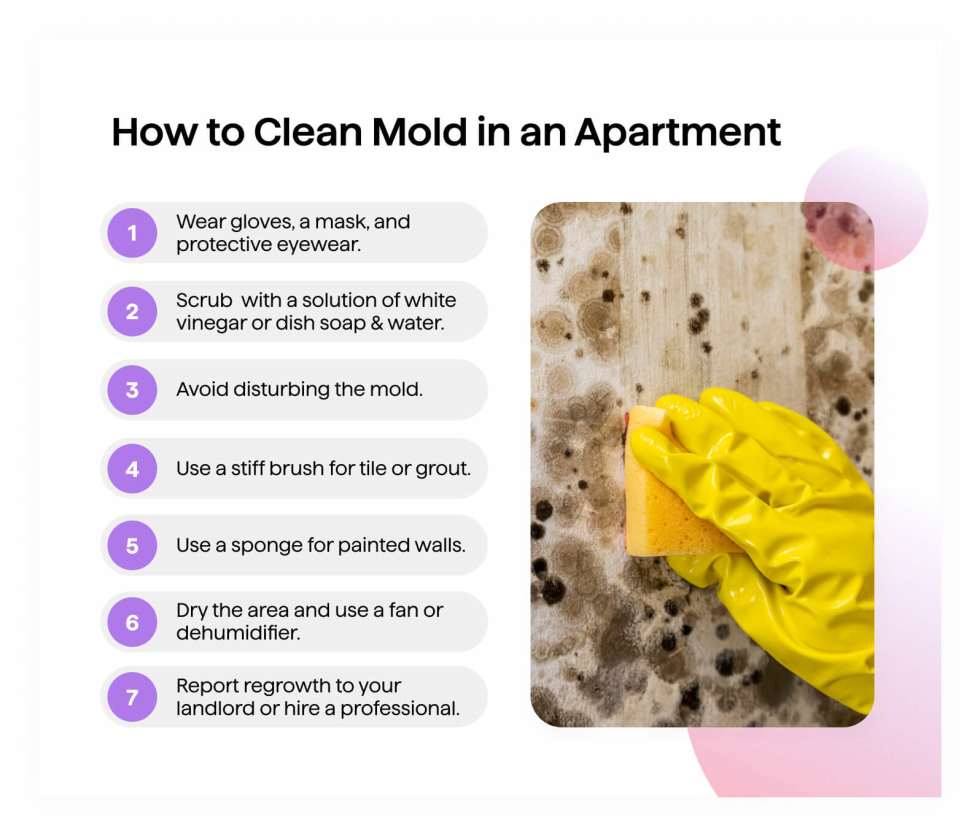
If you’re dealing with more than a small patch of mold or it keeps coming back after you clean it, you may need professional intervention. Hidden mold may be lurking in insulation, HVAC systems, or behind drywall. A professional mold remediation expert is skilled at safely removing the problem before it spreads. Call your landlord to talk through solutions, including identifying different mold types and how to address the problem.
In most cases, your landlord will cover the cost of a mold remediation service. Check the terms of your lease agreement. If there’s no mention of mold-cleaning services, document all the evidence of mold. You may be living in uninhabitable conditions.
It’s also wise to document all of the discussions you had with your landlord about the issue, their response, any resolution, and next steps. If you need to take legal action, you want a paper trail to prove you tried to work with your landlord.
What kind of mold examples are you dealing with? Whether you’re dealing with dusty green fuzz on your windowsill or dark spots creeping up the bathroom wall, knowing the types of mold in apartments can help you act quickly and protect your health.
Ready to find a mold-free apartment? Take the quick Apartment List quiz to narrow your search. With us, you’ll spend five minutes and save 50 hours searching.
While some mold is easy to identify by color or texture, lab testing is the only way to know for sure. If you're concerned, contact your landlord or a house mold inspection service.
Not necessarily. Many types of mold are simply allergens, but others can cause serious health problems. When in doubt, treat mold seriously and get it assessed and professionally removed.
Mold caused by negligence or failure to repair water damage may be grounds for breaking a lease, depending on local tenant laws. Always document and report the issue first.
Some renters insurance policies cover mold if it’s the result of a covered peril (like a burst pipe), but not all do. Check your policy or contact your insurance provider for more information.
While there are estimated to be more than 1 million types of mold, the five main types found in a household are Cladosporium, Aspergillus, Penicillium, Stachybotrys chartarum, and Alternaria.
Musty, damp smells often indicate hidden growth. You should also check high-moisture areas like under sinks, around windows, in basements, and behind appliances for discoloration, stains, or peeling paint. If you're still unsure, consider using a flashlight to inspect dark corners or get a professional mold test for confirmation.
To remove mold in your apartment, start by cleaning small areas with white vinegar or a store-bought mold remover, making sure the space is well-ventilated. Bleach will only mask the problem by wiping away the surface and not getting rid of it at the source. If the mold covers more than a square foot or keeps returning, it’s time to contact your landlord or a licensed mold specialist.


In unit laundry, Patio / balcony, Granite counters, Pet friendly, Stainless steel, Walk in closets + more
In unit laundry, Granite counters, Hardwood floors, Dishwasher, Pet friendly, 24hr maintenance + more